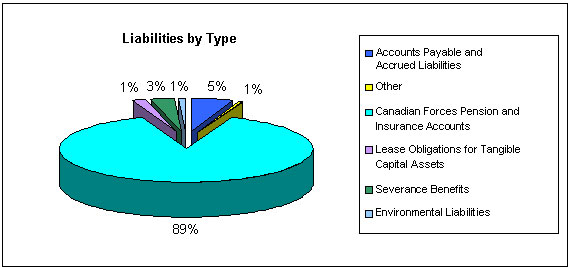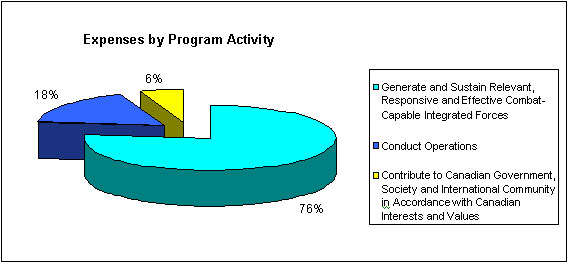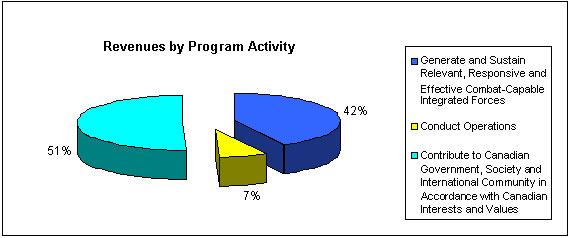Common menu bar links
Breadcrumb Trail
ARCHIVED - National Defence
 This page has been archived.
This page has been archived.
Archived Content
Information identified as archived on the Web is for reference, research or recordkeeping purposes. It has not been altered or updated after the date of archiving. Web pages that are archived on the Web are not subject to the Government of Canada Web Standards. As per the Communications Policy of the Government of Canada, you can request alternate formats on the "Contact Us" page.
SECTION III: SUPPLEMENTARY INFORMATION
Financial Highlights
The financial information presented within this report is intended to serve as a general overview of Defence's financial position and operations. The Department's financial statements can be found on Defence web site at: http://www.vcds.forces.gc.ca/sites/page-eng.asp?page=5609.
Condensed Statement of Financial Position
| (in thousands of Dollars) | Percentage Variance |
2009 | 2008 | |
|---|---|---|---|---|
| Assets | Total Assets | 5% | 36,155,540 | 34,304,900 |
| Liabilities | Total Liabilities | 3% | 51,118,741 | 49,807,921 |
| Equity | Total Equity | -3% | (14,963,201) | (15,503,021) |
| Total | 5% | 36,155,540 | 34,304,900 | |
Condensed Statement of Operations
| (in thousands of Dollars) | Percentage Variance |
2009 | 2008 | |
|---|---|---|---|---|
| Expenses | Total Expenses | 10% | 18,501,793 | 16,819,879 |
| Revenues | Total Revenues | 4% | 524,240 | 504,484 |
| NET COST OF OPERATIONS | 10% | 17,977,553 | 16,315,395 | |
Financial Highlights Charts

Total assets were $36.2 billion at the end of 2008-09, an increase of $1.9 billion (5%) over the previous year's total assets of $34.3 billion. Tangible Capital Assets comprised 82% of total assets at $29.7 billion. Inventories represented $5.5 billion (15%) while Prepaid Expenses represented $0.8 billion (2%) of total assets.

Total liabilities were $51.1 billion at the end of 2008-09, an increase of $1.3 billion (3%) over the previous year's total liabilities of $49.8 billion. Canadian Forces Pension and Insurance Accounts represent the largest portion of liabilities at $45.4 billion or 89% of total liabilities.

Total expenses for the Department of National Defence were $18.5 billion in 2008-09. The majority of expenses, $14.2 billion or 76%, were spent in support of the program activity undertaken to Generate and Sustain Relevant, Responsive and Effective Combat-Capable Integrated Forces.

The Department's total revenues amounted to $524.2 million for 2008-09, an increase of $19.8 million (4%) over the previous year's total revenues of $504.5 million. Almost half or $265.2 million (51%) of the revenue was derived from the program activity undertaken to Contribute to Canadian Government, Society and International Community in Accordance with Canadian Interests and Values. Another $220.7 million (42%) of the revenue was related to the Generate and Sustain Relevant, Responsive and Effective Combat-Capable Integrated Forces program activity.
Supplementary Information Tables
The following information is available on the Treasury Board Secretariat's website at: http://www.tbs-sct.gc.ca/dpr-rmr/st-ts-eng.asp.
- Table 1: Sources of Respendable and Non-Respendable Revenue
- Table 2: Details on Project Spending (Capital Equipment Program) over $30M
- Table 3: Status Report on Major Crown Projects
- Table 4: Summary of Transfer Payment Programs by Activity
- Table 5: Sustainable Development Strategy
- Table 6: Green Procurement
- Table 7: Response to Parliamentary Committees and External Audits
- Table 8: Internal Audits and Evaluations
Other Items of Interest
The following information can be found on the Defence website at http://www.vcds.forces.gc.ca/sites/page-eng.asp?page=5609.
- National Defence Organization Chart
- Legislation and Regulations Administered
- Key Partners and Stakeholders
- Overview of Delivery Mechanisms
- Summary of Financial and Human Resources
- Contribution of Defence Priorities to Strategic Outcomes
- Defence Program Activity Architecture Chart
- Relationship Between Defence Priorities and Program Activities
- Departmental Link to Government of Canada Outcome Areas
- Cost Estimates for CF Domestic and Continental Operations
- Cost Estimates for CF International Operations
- Reserve Force
- Reserve Force Expansion Annual Strength Report
- Regular Force Attrition Trend
- Work Environment
- Distribution of Actual Spending by Strategic Outcome
- Summary of Capital Spending by Program Activity
- Capital Construction Program (Spending over $60M)
- Details on Transfer Payment Programs over $5M
- Details on Transfer Payment Programs (Narrative)
- Expenditure Management Review
- Internal Services
- Selected Defence Portfolio HR and Financial Resources
- Reserve Force
- National Search and Rescue Secretariat
- Communications and Security Establishment Canada
- Defence Research and Development Canada
- The Office of the Judge Advocate General
- The Office of the Ombudsman for the Department of National Defence and the Canadian Forces
Acronyms
A
ADM(FinCS) - Assistant Deputy Minister (Finance and Corporate Services)
ADM(IM) - Assistant Deputy Minister (Information Management)
ANA - Afghan National Army
ANP - Afghan National Police
ANSF - Afghan National Security Forces
AODP - Apprenticeship and Operational Development Program
C
C4ISR - Command, Control, Communications, Computers, Intelligence, Surveillance and Reconnaissance
Canada COM - Canada Command
CANSOFCOM - Canadian Special Operations Forces Command
CDMA - Conference of Defence Ministers of the Americas
CEFCOM - Canadian Expeditionary Force Command
CFB - Canadian Forces Base
CIC - Cadet Instructors Cadre
CIDA - Canadian International Development Agency
CF - Canadian Forces
CFDS - Canada First Defence Strategy
CFRG - Canadian Forces Recruiting Group
CRPG - Canadian Ranger Patrol Group
CSPS - Canada School of Public Service
CTF - Combined Task Force
D
DFAIT - Foreign Affairs and International Trade Canada
DND - Department of National Defence
DPR - Departmental Performance Report
E
EDIS - DND Estimated Expenditures by Electoral District and Province
EPA - Effective Project Approval
ERC - Expenditure Review Committee
F
FOC - Full Operational Capability
FTE - Full-Time Equivalent
G
GHG - Greenhouse Gas
GPS - Global Positioning System
GST - Goods and Services Tax
H
HR - Human Resources
HRMS - Human Resources Management System
I
ICSAR - Interdepartmental Committee on Search and Rescue
IED - Improvised Explosive Device
IEDD - Improvised Explosive Device Disposal
IM/IT - Information Management / Information Technology
IOC - Initial Operational Capability
IRB - Industrial and Regional Benefits
IRP - Integrated Relocation Program
ISAF - International Security Assistance Force
ITAR - International Traffic in Arms Regulations
J
JCR - Junior Canadian Rangers
JIATF(S) - Joint Interagency Task Force (South)
JPSU - Joint Personnel Support Unit
JTF - Joint Task Force
JTFN - Joint Task Force North
L
LAV - Light Armoured Vehicle
M
M&R - Maintenance and Repair
MDA - MacDonald, Dettwiler and Associates Ltd.
MOU - Memorandum of Understanding
MSOC - Marine Security Operations Centre
MTAP - Military Training Assistance Program
N
NATO - North American Treaty Organization
NORAD - North American Aerospace Defense Command
NSS - National Search and Rescue Secretariat
O
O&M - Operations and Maintenance
OAG - Office of the Auditor General
OGD - Other Government Department
OGGO - Office of Greening Government Operations
OMLT - Operational Mentor and Liaison Team
OSI - Operational Stress Injury
OSISS - Operational Stress Injury Social Support
P
PAA - Program Activity Architecture
PMO - Project Management Office
PPA - Preliminary Project Approval
PWGSC - Public Works and Government Services Canada
R
RCMP - Royal Canadian Mounted Police
RFP - Request for Proposal
RPP - Report on Plans and Priorities
RPSR - Revised Pay System for the Reserves
S
SAR - Search and Rescue
SDS - Sustainable Development Strategies
SNMG1 - Standing NATO Response Force Maritime Group One
SOIQ - Solicitation of Interest Qualification
T
TB - Treasury Board
TLD - Third Location Decompression
U
UAV - Unmanned Aerial Vehicle
UN - United Nations
UOR - Unforcasted Operational Requirements
V
VAC - Veteran Affairs Canada
W
WFP - World Food Program
Y
YFR - Yearly Flying Rates
YOS - Year of Service
Contact Listing
| Vice-Admiral J.A.D. Rouleau, CMM, MSM, CD Vice-Chief of the Defence Staff National Defence Headquarters 101 Colonel By Drive Ottawa, Ontario K1A 0K2 |
Telephone: (613) 992-6052 Facsimile: (613) 992-3945 |
| Mr. Kevin Lindsey Assistant Deputy Minister (Finance and Corporate Services) National Defence Headquarters 101 Colonel By Drive Ottawa, Ontario K1A 0K2 |
Telephone: (613) 992-5669 Facsimile: (613) 992-9693 |
| Ms. Jos�e Touchette Assistant Deputy Minister (Public
Affairs) National Defence Headquarters 101 Colonel By Drive Ottawa, Ontario K1A 0K2 |
Telephone: (613) 995-2534 Facsimile: (613) 992-4739 TTY/TDD: 1 800 467-9877 Email: information@forces.gc.ca |
| Department of National Defence | www.forces.gc.ca |
| Office of the Judge Advocate General | www.forces.gc.ca/jag/index-eng.asp |
| Office of the Ombudsman for National Defence and the Canadian Forces | www.ombudsman.forces.gc.ca |
| National Search and Rescue Secretariat | www.nss.gc.ca |
| Defence Research and Development Canada | www.drdc-rddc.gc.ca |
| Communications Security Establishment Canada | www.cse-cst.gc.ca |
| Defence Planning and Management | www.vcds-vcemd.forces.gc.ca |
[2] The Department of National Defence (DND) and the Canadian Forces (CF) and the organizations and agencies that make up the full Defence portfolio are collectively referred to as Defence.
[3] Capital Spending is included in Departmental Spending
[4] Explanatory notes are provided in Section III: Other Items of Interest - Summary of Financial and Human Resources.
[5] The civilian workforce includes employees from the Department of National Defence and the following Defence Portfolio organizations: Communications and Security Establishment Canada (CSEC), National Search and Rescue Secretariat (NSS), and the Office of the Ombudsman (OMB).
[6] Trained effective strength refers to the number of personnel trained to an employable standard for their occupation.
[7] Choke point is defined as any natural or artificial feature or structure that creates a constricted route thereby restricting manoeuvre or movement.
[8] In this sub-section of the report, civilian(s) refers to individuals who are not on active duty in the armed services or members of a fighting force. Civilians may include, but are not limited to, members of the civilian workforce employed with the Department of National Defence, civilians employed with or by other government organizations such as diplomats, development specialists and corrections officers, as well as police seconded from the Royal Canadian Mounted Police and provincial and municipal forces across the country.
[9] Canada's Engagement in Afghanistan, Report to Parliament, March 2009
[10] Ibid.
[11] Canada's Engagement in Afghanistan, Report to Parliament, March 2009
[12] Ibid
[13] IEDs are insurgents' weapon of choice and have contributed to over 55 percent of CF fatalities from 2002 through to the end of the fiscal year.
[14] Canada's Engagement in Afghanistan, Report to Parliament, March 2009
[15] Ibid
[16] Trained effective strength refers to the number of personnel trained to an employable standard for their occupation.
[17] Collective Work Description: A work description that records the work assigned to a number of identical positions at the same occupational group and level. This type of work description can describe identical work across organizational boundaries.
[18] Report of the Expert Panel on Integrated Business and Human Resources Planning in the Federal Public Service
[19] Refers to science advisors "reaching back" to seek specialized support or direct assistance from resources not present at the site.
